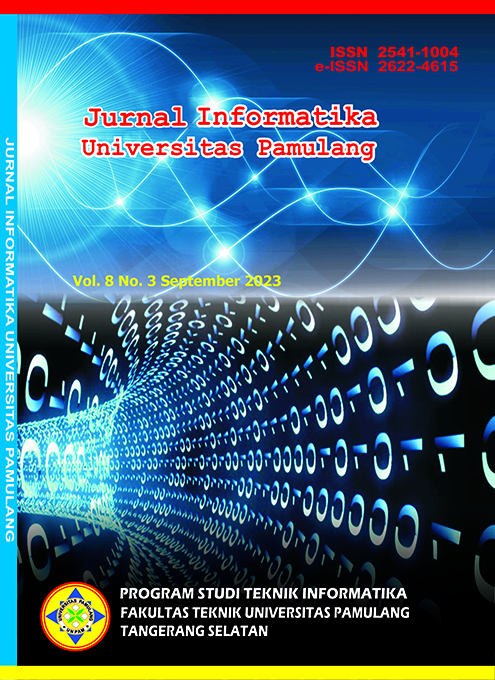Klasifikasi Status Stunting Balita Menggunakan Metode Naïve Bayes Gaussian Berbasis Web
DOI:
https://doi.org/10.32493/informatika.v8i3.33399Keywords:
Toddler, Stunting, Data Mining, Classification, Naïve BayesAbstract
The growth and development of toddlers must get attention from parents because toddlerhood is a golden period in shaping the growth and development and intelligence of children. Stunting is a state of malnutrition in which stunted growth and development of children and this is included in chronic nutritional problems, the incidence of stunting can be seen from height that is not in accordance with age. In preventing toddlers from stunting, it is necessary to anticipate early prevention by conducting examinations at the nearest posyandu which is measured using anthropometric methods. The calculation of stunting or normal status based on anthropometric data is generally processed manually so that there is a high possibility of errors in calculating and entering data. Data mining can make classifications or predictions on the stunting status of toddlers by studying previous data patterns. Naïve bayes is one classification method that has the advantage of high accuracy with little training data as for the attributes used in this study, namely age, gender, Early Initiation of Breastfeeding (IMD), weight, height. Based on the test results, the best average accuracy was obtained on numerical data types for age, weight, height and nominal gender attributes, Early Breastfeeding Initiation (IMD) with the highest accuracy in the 80:20 data comparison, which is 80.34% with a total of 1172 data.
References
Arisandi, R. R. R., Warsito, B., & Hakim, A. R. (2022). Aplikasi Naïve Bayes Classifier (Nbc) Pada Klasifikasi Status Gizi Balita Stunting Dengan Pengujian K-fold Cross Validation. Jurnal Gaussian, 11(1), 130–139. https://ejournal3.undip.ac.id/index.php/gaussian/
Cahyanti, F. L. D., Sarasati, F., Astuti, W., & Firasari, E. (2023). Klasifikasi Data Mining Dengan Algoritma Machine Larning Untuk Prediksi Penyakit Liver. Technologia, 14(2), 134–139. https://doi.org/http://dx.doi.org/10.31602/tji.v14i2.10093
Dewi, S. (2019). Komparasi Metode Algoritma Data Mining pada Prediksi Uji Kelayakan Credit Approval pada Calon Nasabah Kredit Perbankan. Jurnal Khatulistiwa Informatika, 7(1), 59–65. https://doi.org/https://doi.org/10.31294/jki.v7i1.5744
Dewi, S. K., & Fuad, A. (2022). Strategi Segmenting, Targeting, dan Positioning dalam Rangka Percepatan Penurunan Stunting di Provinsi Banten. JDKP Jurnal Desentralisasi Dan Kebijakan Publik, 3(2), 398–406. https://doi.org/10.30656/jdkp.v3i2.5914
Yanti, N. D., Betriana, F., & Kartika, I. R. (2020). Faktor Penyebab Stunting Pada Anak: Tinjauan Literatur. REAL in Nursing Journal (RNJ), 3(1), 1–10. https://doi.org/http://dx.doi.org/10.32883/rnj.v3i1.447
Islam, H. I., Mulyadien, M. K., & Enri, U. (2022). Penerapan Algoritma C4.5 dalam Klasifikasi Status Gizi Balita. Jurnal Ilmiah Wahana Pendidikan, 8(10), 116–125. https://doi.org/10.5281/zenodo.6791722
Nugroho, M. R., Sasongko, R. N., & Kristiawan, M. (2021). Faktor-faktor yang Mempengaruhi Kejadian Stunting Pada Anak Usia Dini di Indonesia. Jurnal Obsesi: Jurnal Pendidikan Anak Usia Dini, 5(2), 2269–2276. https://doi.org/10.31004/obsesi.v5i2.1169
Putro, H. F., Vulandari, R. T., & Saptomo, W. L. Y. (2020). Penerapan Metode Naive Bayes Untuk Klasifikasi Pelanggan. Jurnal Teknologi Informasi Dan Komunikasi (TIKomSiN), 8(2), 19–24. https://doi.org/10.30646/tikomsin.v8i2.500
Rachmad, D. U. M., Oktavianto, H., & Rahman, M. (2022). Perbandingan Metode K-Nearest Neighbor Dan Gaussian Naive Bayes Untuk Klasifikasi Penyakit Stroke. Jurnal Smart Teknologi, 3(4), 405–412.
Rahmadhita, K. (2020). Permasalahan Stunting dan Pencegahannya Stunting Problems and Prevention. Jurnal Ilmiah Kesehatan Sandi Husada, 11(1), 225–229. https://doi.org/10.35816/jiskh.v10i2.253
Ruswati, Leksono, A. W., Prameswary, D. K., Pembajeng, G. S., Inayah, Felix, J., Dini, M. S. A., Rahmadina, N., Hadayna, S., Aprilia, T. R., Hermawati, E., & Ashanty. (2021). Risiko Penyebab Kejadian Stunting pada Anak. Jurnal Pengabdian Kesehatan Masyarakat: Pengmaskesmas, 1(2), 34–38. https://doi.org/10.31849/pengmaskesmas.v1i2/5747
Setiawan, R., & Triayudi, A. (2022). Klasifikasi Status Gizi Balita Menggunakan Naïve Bayes dan K-Nearest Neighbor Berbasis Web. JURNAL MEDIA INFORMATIKA BUDIDARMA, 6(2), 777–785. https://doi.org/10.30865/mib.v6i2.3566
Titimeidara, M. Y., & Hadikurniawati, W. (2021). Implementasi Metode Naive Bayes Classifier Untuk Klasifikasi Status Gizi Stunting Pada Balita. Jurnal Ilmiah Informatika (JITF), 9(1), 54–59. https://doi.org/https://doi.org/10.33884/jif.v9i01
World Health Organization. (2014, December 20). Global nutrition targets 2025: policy brief series. World Health Organization. https://www.who.int/publications/i/item/WHO-NMH-NHD-14.2
World Health Organization. (2015, September 19). Stunting in a nutshell. World Health Organization. https://www.who.int/news/item/19-11-2015-stunting-in-a-nutshell
World Health Organization. (2022). Stunting prevalence among children under 5 years of age (%) (model-based estimates). World Health Organization. https://www.who.int/data/gho/data/indicators/indicator-details/GHO/gho-jme-stunting-prevalence
Downloads
Published
Issue
Section
License
Copyright (c) 2023 Makmur Mulyono, Elvia Budianita, Alwis Nazir, Fadhilah Syafria

This work is licensed under a Creative Commons Attribution-NonCommercial 4.0 International License.
Authors who publish with this journal agree to the following terms:
- Authors retain copyright and grant the journal right of first publication with the work simultaneously licensed under a Creative Commons Attribution-NonCommercial 4.0 International (CC BY-NC 4.0) that allows others to share the work with an acknowledgement of the work's authorship and initial publication in this journal.
- Authors are able to enter into separate, additional contractual arrangements for the non-exclusive distribution of the journal's published version of the work (e.g., post it to an institutional repository or publish it in a book), with an acknowledgement of its initial publication in this journal.
- Authors are permitted and encouraged to post their work online (e.g., in institutional repositories or on their website) prior to and during the submission process, as it can lead to productive exchanges, as well as earlier and greater citation of published work (See The Effect of Open Access).
Jurnal Informatika Universitas Pamulang have CC-BY-NC or an equivalent license as the optimal license for the publication, distribution, use, and reuse of scholarly work.
In developing strategy and setting priorities, Jurnal Informatika Universitas Pamulang recognize that free access is better than priced access, libre access is better than free access, and libre under CC-BY-NC or the equivalent is better than libre under more restrictive open licenses. We should achieve what we can when we can. We should not delay achieving free in order to achieve libre, and we should not stop with free when we can achieve libre.
Jurnal Informatika Universitas Pamulang is licensed under a Creative Commons Attribution-NonCommercial 4.0 International (CC BY-NC 4.0)
YOU ARE FREE TO:
- Share : copy and redistribute the material in any medium or format
- Adapt : remix, transform, and build upon the material for any purpose, even commercially.
- The licensor cannot revoke these freedoms as long as you follow the license terms





